| Columns Retired Columns & Blogs |
"That's Amore" ........ Dean Martin :-) ...........
I used DRA Labs' MLSSA system and a calibrated DPA 4006 microphone to measure the Spendor A7's frequency response in the farfield, and an Earthworks QTC-40 mike for the nearfield responses. The Spendor's specified sensitivity is 88dB/2.83V/m; my estimate was close, at 87.1dB(B)/2.83V/m. The specified impedance is 8 ohms. Fig.1 shows that the A7's impedance magnitude (solid trace) remains above 8 ohms for the entire treble and most of the low bass. The minimum magnitude was a still-high 6.1 ohms at 228Hz, and while the electrical phase angle is sometimes high, this is always when the impedance is also high, mitigating any drive difficulty.
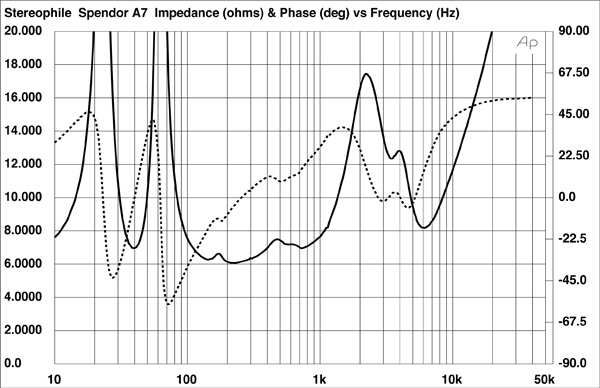
There is a small peak between 100 and 200Hz in the impedance-magnitude trace, but I found no enclosure problem in that region when I investigated the panels' vibrational behavior with a plastic-tape accelerometer. I did find some resonant modes on the sidewalls, the front baffle, and the rear panel. However, these were all relatively low in level, and the most significant modes—on the sidewalls, 12" from the base (fig.2)—were high enough in frequency and Quality factor (Q) to have no audible consequences.
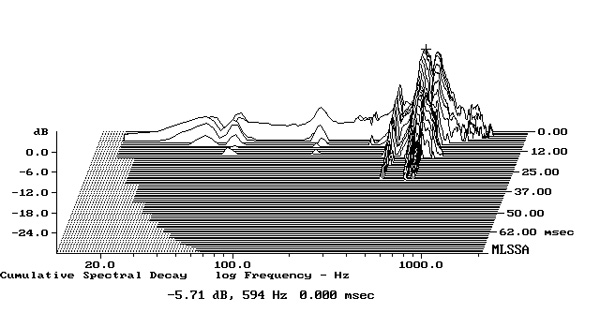
The impedance-magnitude plot has the expected low-frequency saddle indicating the tuning of the port. The blue trace in fig.3 shows the woofer's nearfield response—it has a minimum-motion notch at 39Hz, which is when the back pressure from the port resonance holds the cone stationary. The ports' nearfield response (red trace) peaks slightly higher in frequency, and its upper-frequency rolloff is disturbed not only by three resonances in the midrange but also by a strong peak at 171Hz, this coincident with the impedance peak noted earlier. This mode is both strong and out of phase with the woofer's output—when I calculated the complex sum of the woofer and port responses in the ratio of their radiating areas, taking into account their different distances from a nominal farfield microphone position, there was a major notch centered on 171Hz. I suspect that, with the A7's woofer mounted close to the top of the baffle and the port at the base of the speaker's rear panel, there is some sort of organ-pipe resonance at this frequency. Ken Micallef didn't note any congestion in the upper bass; in fact, he was impressed by the solidity of the A7's bass and low-frequency extension. But this behavior might have been a reason he at first had some trouble sorting out the best positions for the Spendors in his room.
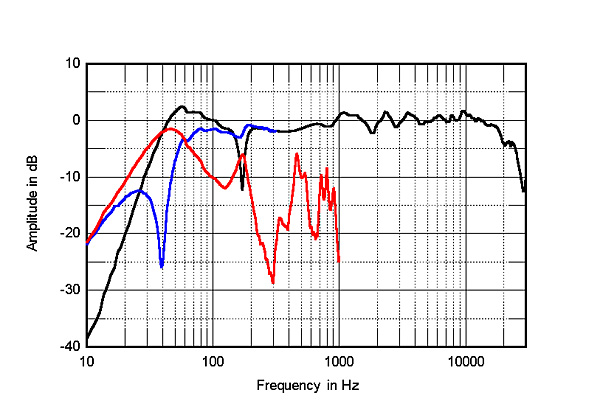
Higher in frequency in fig.3, the black trace shows the Spendor's farfield response, averaged across a 30° horizontal window centered on the tweeter axis. It is impressively flat, with small peaks balanced by equally small dips. The plot of the A7's horizontal dispersion (fig.4) indicates that the speaker becomes relatively directional at the top of the woofer's passband, with then a slight off-axis flare in the bottom octave of the tweeter's passband. This behavior might lend the balance a touch of brightness in small and/or underdamped rooms—perhaps it correlates with KM's "touch of treble zing! in strings and guitars." In the vertical plane (fig.5), a sharply defined suckout at 3.9kHz develops 10° above the tweeter axis, confirming the specified crossover frequency of 3.7kHz. With the speaker on spikes, the tweeter is a low 34.5" above the floor; listeners should not sit too high.
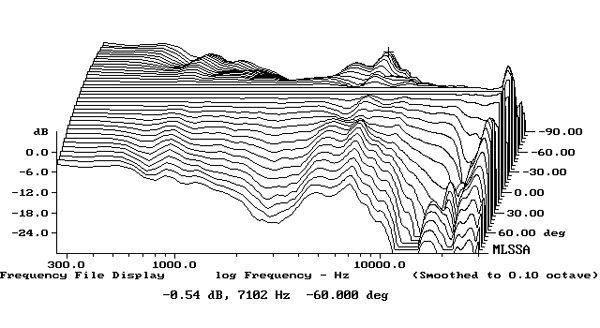
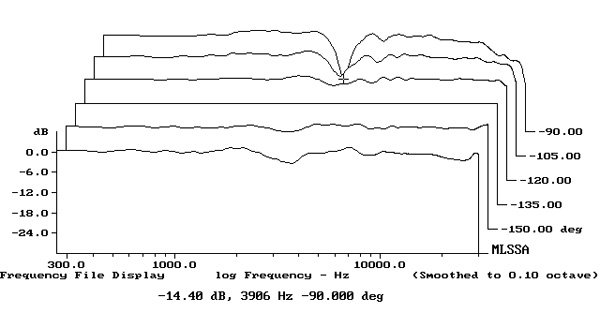
Turning to the time domain, the A7's step response (fig.6) indicates that its tweeter is connected in inverted acoustic polarity, the woofer in positive polarity. This is a "very English" step response: the tweeter's step has almost fully decayed by the time the woofer's step arrives at the mike. (Ever since the BBC's classic LS3/5a of the mid-1970s, many British two-way speakers have had similar step responses.) The Spendor's cumulative spectral-decay plot (fig.7) was generally clean, though with some low-level delayed energy at the top of the woofer's passband.
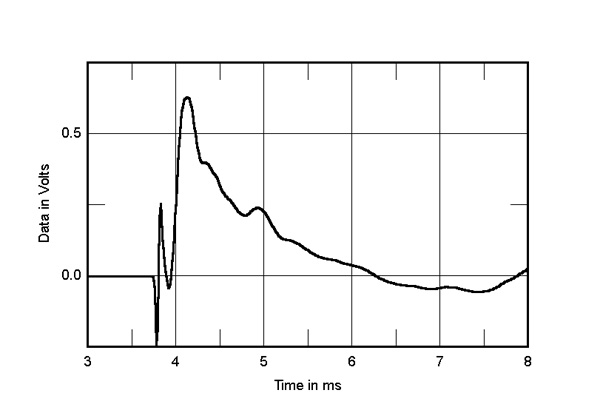
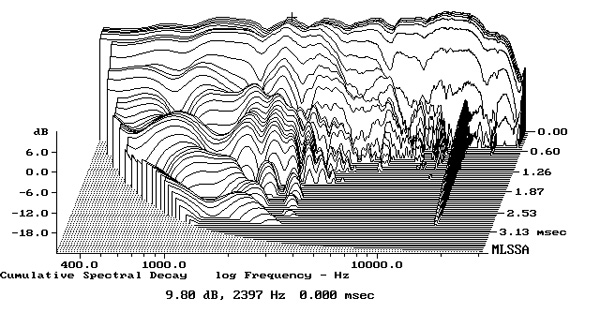
Other than that peculiar port resonance mode, the A7 offers good measured performance, as I have come to expect from Spendor and its team of managing director Philip Swift and the company's Technical Design Manager Terry Miles.—John Atkinson

"That's Amore" ........ Dean Martin :-) ...........

... post a list of dealers on their website instead of requiring you to contact them for the info?

Joseph Audio has the same plan.
Someone might want to know where their local dealer is, in case they happen to be in the area and might find a visit to be worth a detour, even if they are not planning an immediate purchase. In some cases, especially with high-end gear, the "local" dealer could be hundreds of miles away and unknown to the prospective customer.

$5k is expensive for such a diminutive speaker.

So a 7" mid/woofer, quite ordinary, usual regular sized magnet, nothing fancy, a silk dome, regular tweeter, and zoom, $5k!Spend (or) indeed!
There are plenty of alternatives to this easy money grabber: take top of the line drivers such as Davis 20 TK8 and TW26K2R for instance and you are already at 94dB/w/m instead of this meager 88db/w/m.

(4) 6.5" bass drivers, 5" midrange, 1" tweeter (all aluminum - sorry almuminium) 90dB sensitivity, 51" tall, 83lbs. None of the specs or measurements matter if it does not sound great, which it does - glorious in fact. Oh yeah, the price: $5K
No, I have not heard the Spendor, so I really cannot pass judgement on its perceived value. Just saying KEF and others offer a lot of speaker for the same price. Who know, maybe the A7 is sublime and its performance alone justifies the cost... My nearest dealer is 300 miles away, so a demo is not in the works in the foreseeable future.

May be Stereophile could review KEF R11 :-) ...........
Chances are KEF R11 has better midrange isolation (hence, better reproduction) and more bass extension than Spendor A7, for the same price .... and may be a 'better bang for the buck' :-) ..........

Bass extension cannot be expressed by a single figure.
KEF's tend to have very steep low end cut off. The new R11 and R7 have that tendency, too, as seen in Stereoplay measurements.
Spendor's are different. D7 is spec'ed down to 27Hz in catalog, but the port tuning frequency is lower than 27Hz in Stereophile measurement. Few manufacturers do that.

KEF = made in China. Take it from here Tony from Michigan.

KEFs are developed in Maidstone, Kent, by an unusuallly large team of specialised engineers, using highly advanced development methods. Production, these days, too requires a great deal of development to keep product quality up. KEFs are thus by no means Chinese speakers, low in quality or a betrayal of English workers, or whatever you want to say. They are however designed, simulated and virtually tested using computing power relying on Chinese made HW. So does the device from which you read my comment.

to the actual end product and I know that their world class R&D team is UK based.
Was really just stating facts about the "artisinal aspect" of Spendor vs. the larger international conglomerate aspect of KEF products. Apart from the old KEF 107/2's, I have not been a fan of their more recent products, finding them for a lack of a better word, sterile sounding. I know some people like the sound of their products, it's just not the sonic profile I enjoy enough to own. M

Had A7 for two weeks home demo and they are for sure excellent speakers. There are many more expensive speakers that sound inferior. So you can say that price is good if you consider insane prices that all main manufacturers have today. Of course there are still exceptions, you can still get excellent speakers for very reasonable price. For example Kralk audio speakers http://kralkaudio.com/

is that they actually look like speakers.

So let me get this right. . .
Ken Micallef– DeVore Orangutan O/93
Art Dudley– DeVore Orangutan O/96
Rafe Arnott–DeVore Gibbon X
Michael Lavorgna–DeVore Gibbon X
Jim Austin–DeVore Gibbon X
I guess I'm gonna have to find a dealer and have a listen to some DeVores.

... each of the reviewers has acquired the equipment that comprises their reference systems? Has it been bought outright (and at list/street price versus with a substantial accommodation discount), or is it on a free loan from the manufacturer/importer for some indefinite period of time?

whether or not reviewers own or borrow equipment. It reeks of jealousy masquerading as journalistic integrity. Hate to call him on it but it's pretty obvious that it bothers him. Sour audio grapes.

... when you see a video of a certain speaker manufacturer schmoozing with reviewers at "the barn" it could cause you to further speculate about the specifics of the manufacturer-reviewer relationship.
HP of TAS was (in)famous for having equipment on indefinite loan, leading one to question the extent to which such arrangements might have biased the outcome of his reviews.
Thus, it would be useful to know whether or not the reference equipment a particular reviewer uses has been acquired with their own funds and on what terms.

...for everything. This way you can trust me three times as much as anyone else.
Michael Lavorgna
Editor
Twittering Machines

... will result in more traffic being driven to your website.

Glad you (ML) are reviewing active speakers :-) .......
There are not many things left to do with passive speakers ......... Almost every trick known to man has already been tried with the passive speakers ....... There is a good reason why most of the studio monitors (speakers) are active speakers, these days :-) ..........

The discontinued Bose 901 is virtually active. There is nothing other than the nine drivers for the amplifier.
The line level EQ unit does the job of adjustment as in active monitor speakers. It just happens that the line level circuit is outside the speaker enclosure.

I was referring to the modern day active speakers, where multiple amplifiers are directly connected to multiple drivers (transducers) ........ An active crossover is placed before the amplifiers and, that crossover directs different frequencies to those different amplifiers :-) ..........
In most of these active speakers, the crossover, amplifiers and the drivers are all in the same enclosure :-) .........

"Brave New World" .......... Greta Van Fleet :-) ..........

May be you (ML) could also review the Cube Audio top of the line 10 inch 'single driver' loudspeakers? :-) .........

Is that 'collusion'? :-) ........

1) today’s widely accessible resources allow virtually any competitive design to achieve a decent level of relative performance and thus 2) it finally all comes down to personal taste, which is imponderably, well, personal – any kind of general consensus on the "undeniable superiority" of certain products (not only reccuring brands or models but also fancy formats, magic topologies etc) should promptly raise suspicions of vested interest, self-deception, hype-conformism or, most likely, an amusing combination of the three.

... part of your reference system?

You should hold our corrupt GOP politicians to the same standard and with the same fervor that you want to investigate our audio reviewers and their owned, discounted or loaned equipment.

Now ... 'That's Amore' X 5 :-) ..........

I'd take a Gibbon 88 over the Spendors in a heartbeat. Upgraded to Spendor's MANY years ago from my beloved Spica TC-50s and while the Spendors were a "better" speaker in every way per se, they didn't have the musical magic of the Spicas. Recaptured that magic with Jean Marie Reynaud speakers but if I wanted to upgrade it would be new Reynaud's vs. DeVore Gibbon 88s. I've heard them and they are just natural and musical and tactile and warm and detailed. Not forgiving of crap sources but they sound like the artisinal wooden musical instruments that they actually are. Not metal not kevlar not ceramic not titanium. Not inert. Listen to them if you get the chance. If you like Dylan, any singer songwriter, Blue Note jazz LPs, string quartets, solo piano - this is a speaker for you. They can rock too. Ditto with the JMRs which are quite similar and also beautiful to look at. It's a speaker made like a violin not a car.

Here is something that strikes me as a really bad idea:
https://www.youtube.com/watch?v=d4d7U2tEq4g
Spendor A7 Loudspeaker Deep Unboxing
No appropriate torque wrench was used in the making of this video.

Nobody uses a torque wrench for detaching a wheel from a car.

We should examine whether a Stereophile style single set (vertical 0 degrees) of horizontal off-axis measurements is what we can depend on.
Spendors do not have smooth off-axis response curves in this style of measurements. However, many people feel with their ears the in-room response is seamlessly well balanced.
Revels do have smooth off-axis response curves in this style of measurements. Moreover, many people feel with their ears the in-room response is seamlessly
well balanced.

"In business now for half a century, Spendor also produces its own midrange and bass drivers and, for some models, its own tweeters."
The woofer and tweeter both appear to be Seas Prestige drivers made for Spendor. Very similar Seas tweeters cost around $40 each, and very similar Seas woofers cost around $100 each.
So that really is an expensive cabinet and Spendor name badge.

Not sure about how the us price is determined, but taking the european price (3700euro which always includes VAT!) and converting it to usd would make it 4200.
Whether their price will reduce after uk will eventually leave the eu and may fall back to a wto customs arrangement with the US can be answered already with NO.
So much about social media engineered political decisions to the disadvantage of people, their jobs, companies, and consumers.

Beave,
Negative. The midbass drivers are entirely designed and built in-house. There is a video on their website that shows much of their process and machinery. You won't find any Seas drivers with a plastic cone and bullet phase plug because they don't produce any such driver. The baskets do look similar to some Seas units, but if that's what your conjecture is based on, you might as well assume they're made by Scanspeak also, since many of their drivers uses the same basket pattern. In reality, Spendor baskets are a superior magnesium alloy, which is quite uncommon in the industry. The tweeters are based on a Seas design but made to Spendor's custom specifications.
Ultimately, the cost of the drivers is a mute point considering these small floorstanders outperform most in their price range. Proof is in the listening. Go audition a pair and you'll understand why they cost what they do. Funny how so many judge a book by its cover even though we're cautioned against such folly as early as Kindergarten. Some just can't be bothered with details I suppose.

They might be *assembled* in house, and partially designed in house, but those baskets are from Seas. And Seas does produce drivers with plastic cones and bullet phase plugs. Here's an example using their 'woven' polypropylene cone: http://www.seas.no/index.php?option=com_content&view=article&id=102:h1571-08-u18rnxp&catid=44:utv-prestige-woofers&Itemid=461
Scanspeak doesn't make any drivers with baskets just like these. Similar, perhaps, but not the same.
Seas makes baskets with a magnesium alloy. Just ask Ascend Acoustics if you don't believe me. Their Sierra 2 uses a Seas midwoofer with the magnesium frame. I think Sonus Faber used the same frame in their Liuto line.
The tweeters are Seas units custom made for Spendor.
As for it all being a 'mute' point, I believe your intended word should be 'moot.'
Regarding listening comparisons for these speakers, will the sessions be level-matched? Blinded? I'd be willing to wager that there are several other speakers in this price range that would win in such comparisons. The measurements on these aren't very impressive.

Helomech must be rotorfix from the comments sections in the 'deep unboxing' Youtube video linked above. I guess he followed me here, a year later, to resume the same disagreement.

Wrong. The review clearly states the midbass drivers are made in-house (as Spendor has done for decades), as do many other reviews and their website. So apparently you're claiming they're liars.
Strange that they should decide to expand and purchase a cabinet manufacturing company a few years ago but at the same time begin outsourcing their drivers. It's also strange that they openly admit their tweeters are outsourced, yet feel inclined to mislead reviewers and buyers regarding their other drivers.

Since you insist on continuing this....please define "made in house."
Can they claim the drivers are "made in house" if they take a pre-assembled magnet, motor, and basket, then add their own cone and spider and surround?
Does that mean that they make the entire driver, including every component of the assembly? No, it doesn't.
If they are fully "made in house," does that mean they make their own magnets? Their own voice coil wire? Their own baskets? Their own pole pieces?
Notice in the video on Spendor's website that it shows them making the cone but not the basket or magnet or other parts of the motor.
As for what the review states, most of the reviews here start out by regurgitating ad copy. That doesn't mean much to me.
Aerial Acoustics claimed for a while that their speakers were made in the USA, when in actuality all the components were made oversees. The *assembly* was done in the USA.
Hegel has made similarly misleading claims about their manufacturing location. It's nothing new for audio companies to tell half-truths.

A small single driver at that height can result in a suck out on the frequency response curve somewhere between 150Hz and 400 Hz due to destructive interference with floor reflection in typical domestic condition.
Mordaunt-Short, PSB, etc. put multiple woofers at lower position due to this problem.
The new JBL L100 avoids this problem by a little bit large size woofer (30cm) and low-height matching stand with tilt-back.

The tweeter on Spendor A7 is a dome type with circular symmetry.
However, the top octave response is surprisingly asymmetrical.
In the vertical response family, there is not much roll of at 20kHz at 30 degrees off axis.
In the horizontal response family, there is much roll off at 20kHz at 30 degrees off axis.
Why so different?
In Spendor speakers, something seems to be going on that the Stereophile's horizontal and vertical families of response curves are not catching.

In the vertical response family, there is a suck out at about 4kHz on the 45 degrees off axis response curve.
In the horizontal response family, there is a suck out at about 3kHz on the 45, 50, . . . or 90 degrees off axis response curve.
How can this be?

In the vertical response family, there is a suck out at about 4kHz on the 45 degrees off axis response curve.
This is due to the tweeter and woofer outputs becoming 180 degrees our of phase in the crossover region this far off-axis.
In the horizontal response family, there is a suck out at about 3kHz on the 45, 50, . . . or 90 degrees off axis response curve.
This is due to the woofer becoming very directional at the top of its passband before it crosses over to the tweeter, which has wide dispersion at the bottom of its passband.
John Atkinson
Technical Editor, Stereophile

I am wondering why the frequencies are so much different, 3kHz vs 4 kHz.
In other speakers, the suck out in vertical response and that in horizontal response (if it exists) are similar.
Fig. 5 and 6, Klipsch Forter III
https://www.stereophile.com/content/klipsch-forte-iii-loudspeaker-measurements
Abb 4 and 5, Adam A7
https://www.adam-audio.com/content/uploads/2016/12/review-adam-audio-A7-Sound-and-Recording_german.pdf
I guess BBC speakers use high order crossover, not 1st order one like Thiel, Duntech, etc.

In the more expensive 3-way models of Harbeth or Spendor, they could have used smaller size mid-range driver and reduce or eliminate the suck-out in the horizontal response family. However, even in 3-way models they use 7 or 8 inch mid-range drivers.
So the suck-out in the horizontal response family seems to be intentional. I don't know their intention.
Speakers like Harbeth or Spendor with big suck out in horizontal off axis curves must sound poor to human ears in real rooms, but quite many people like the sound. Some people even say seamless integration between the drive units.

I am wondering why the frequencies are so much different, 3kHz vs 4kHz.
The crossover frequency is 3.9kHz, an octave higher than is usual for a two-way design. So the woofer's radiation pattern between 2kHz and 4kHz is much narrower than the tweeter's above 4kHz. The result is that there is a lack of energy to the sides centered n 3kHz.
With a tower speaker like this Spendor, I can only examine the vertical dispersion over a more limited angle, so the woofer's limited dispersion is not apparent. As I wrote earlier, the suckout at 4kHz is due to destructive interference between the woofer and tweeter outputs at the crossover frequency.
John Atkinson
Technical Editor, Stereophile

Thanks a lot for helpful and kind reply.
By the way, I found that B&W 802 D3 also shows poor looking Spendor style horizontal and vertical response families, instead of good looking Revel style horizontal and vertical response families.
https://www.stereophile.com/content/bowers-wilkins-802-d3-diamond-loudspeaker-measurements
On the internet, some people religiously reject any speaker that does not show Revel style horizontal and vertical response families. According to them, B&W 802 D3 must sound very poor due to uneven reflected sound energy.

As for A7's top end asymmetry, I looked at only several curves next to the reference curve(straight line, on axis) in the horizontal response family for fair comparison. There seems to be more roll off at 15 degrees horizontal off axis than 15 degrees vertical off axis.

B&W 802 D3 and Spendor A7 are similar and Harbeth Supoer HL5 is very different from the other two..
dip in horizontal off axis frequency response curve
B&W 1.9 kHz
Spendor 3 kHz
Harbeth 2.5 kHz
suck out in vertical off axis frequency response curve
B&W 3.6
Spendor 3.9 kHz
Harbeth 2.5 kHz
B&W: 1.9 < 3.6
Spendor: 3.0 < 3.9
Harbeth: 2.5 = 2.5
B&W and Spendor: <
Harbeth: =
https://www.stereophile.com/content/harbeth-super-hl5plus-loudspeaker-measurements